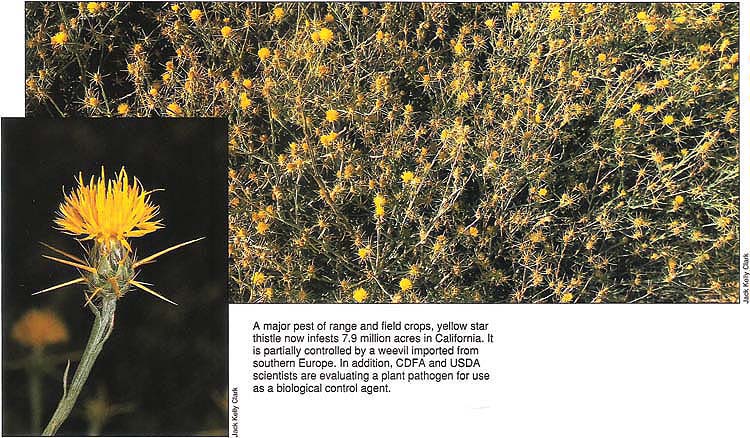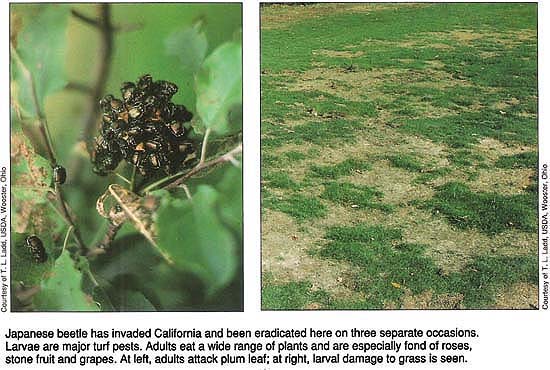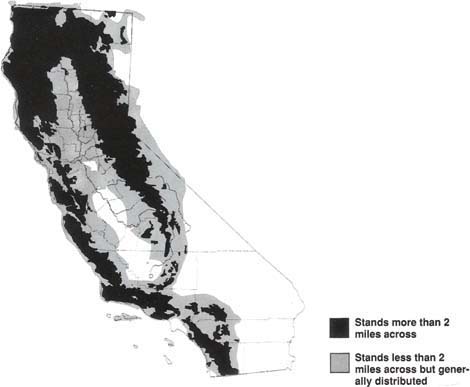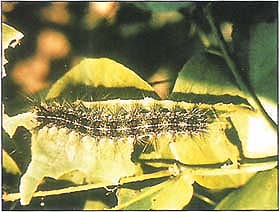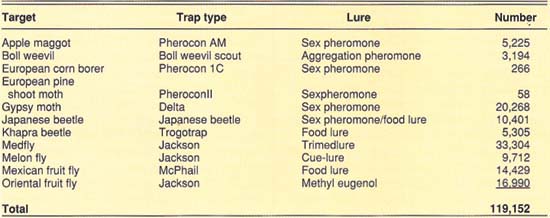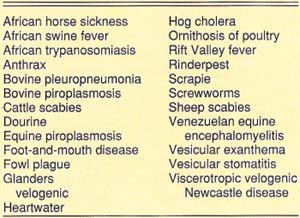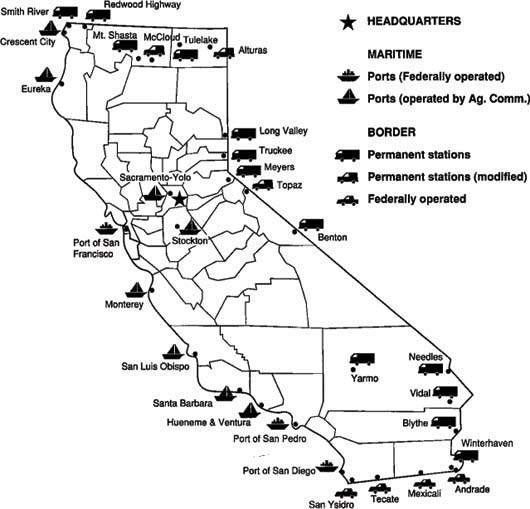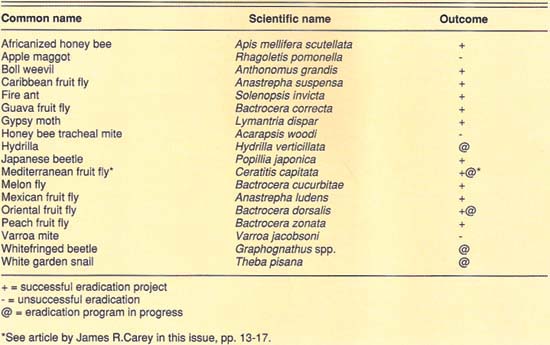All Issues
On the California border, exotic pests pose growing problem for California
Publication Information
California Agriculture 46(1):6-12.
Published January 01, 1992
PDF | Citation | Permissions
Abstract
Major pest threats are profiled, as are the CDFA's exclusion and eradication efforts.
Full text
A major pest of range and field crops, yellow star thistle now infests 7.9 million acres in California. It is partially controlled by a weevil imported from southern Europe. In addition, CDFA and USDA scientists are evaluating a plant pathogen for use as a biological control agent.
California's extensive native flora and fauna, much of which was unique to the state, began changing with the arrival of Spanish settlers who brought many plants, animals and diseases with them. As the rate of human immigration into California has increased, so has the rate at which people bring in exotic (nonendemic) organisms. The magnitude of this influx of alien species is reflected in their contribution to California's biota. More than 10% (>3,000 species) of all plants growing spontaneously in the state are exotic; for our grasslands, the figure is closer to 90%. More than 33% of all freshwater fish were introduced, including brown and brook trout, striped bass, and all species of catfish, sunfish and bass. At least 600 species of invertebrates have successfully invaded California, with another 400 species deliberately released in efforts to biologically control many accidental invaders.
These alien species have had profound effects on California. Golden hills are covered with dried, exotic annual grasses. More than 8.5 million acres of land are planted with introduced crops; another 21.3 million support nonendemic livestock. Approximately 31% of all land is used to grow these alien species.
Exotic pests are responsible for 67% of all crop losses reported. An entire industry has developed to control the introduced insect pests that inhabit our homes.
This article will examine (1) how these exotic species get to California, (2) what effects introduced species are having on the state, (3) the potential effects such organisms may have if they become established and (4) what the California Department of Food and Agriculture (CDFA) is doing to prevent their entry and establishment.
Routes of entry
With few exceptions, exotic species are carried into California by people in vehicles, boats and planes, and through the mail. In fiscal year 1990-91, 104,000 lots of plants and animals were denied entry from the 26 million vehicles passing through CDFA Border Agricultural Inspection Stations. Pests found in these rejected lots included 10 fruit fly species, gypsy moth, Japanese beetle, fire ant, ferret, piranha, root-knot nematode and southern blight fungus.
Examinations of airline passengers and baggage in 1990 detected 420 species of pests, including Mediterranean (medfly), Oriental and Mexican fruit flies, citrus canker and sweet orange scab. An examination of United Parcel Service shipments in 1991 found 5 of 2,446 carrying illegal exotic pests, including the medfly. Of the first class mail parcels examined in 1990-91, 742 parcels contained illegal exotic pests; 61 had larvae of medfly, melon fly, Oriental, or Malaysian fruit flies.
Effects of introduced species
Introduced organisms have had profound effects on California. Below are brief summaries of the effects of five of these organisms on the state.
Grape phylloxera. This insect came to California on grape plants imported to establish a viticulture industry. The pest lives on grape roots and, at sufficient densities, can kill susceptible plants. Between 1850 to 1910, the insect killed 46 million grape plants and was the target of the first modern plant pest quarantine (see sidebar, pp. 9-10). Although the development of resistant rootstocks helped alleviate the problem, the pest caused $8 million in crop losses in 1978. Extensive quarantines inhibit the export of California grape plants to other regions of the U.S. and to foreign countries. The emergence of new phylloxera biotypes capable of attacking the most widely used “resistant” rootstock indicates that this insect is still a major threat to California's $1.6 billion grape industry.
Foot and mouth disease. Foot and mouth disease is a highly contagious viral disease of domestic and wild animals including cattle, swine, sheep and deer. It causes lesions and subsequent erosion of the mouth, feet, teats, udder and rumen.
In February 1924, foot and mouth disease was found in cattle in Alameda County. Surveys soon found infected animals in 16 counties, from Alameda east to Tuolumne and then south to Los Angeles and Orange. Exterior and interior quarantines were established to prevent movement of animals, animal parts, manure, hay, fodder, grain and farm vehicles (unless cleaned and disinfected) from infested areas.
Because the disease is highly contagious and no control measures were known, infected stock were driven into trenches, shot and buried. A total of 109,855 cattle, goats, swine and sheep and 22,214 deer were killed. The program cost approximately $7 million: $4.4 million went to compensation for destroyed animals. This equals approximately $45 million in livestock losses and $35 million in program costs in 1990 dollars.
Citrus tristeza virus. Citrus tristeza virus (CTV) was introduced into California in the early 1900s on imported citrus stock. Rapid decline and death of infected trees was noted in Southern California beginning in 1939. Since then, 3 million CTV-infected trees have been destroyed. Most citrus-growing areas in Southern California, except for the Coachella Valley, are now considered to be generally infested with CTV.
A program was initiated in 1955 to remove all Meyer lemon trees from the Central Valley's citrus-growing areas, as the “old line” Meyer lemons were known carriers of CTV. The first CTV-infected tree in a commercial planting in the area was found in 1956. Since then, CDFA and citrus growers have spent millions of dollars to survey, test and remove CTV-infected trees from commercial plantings in Fresno, Kern and Tulare counties (this program is now funded entirely by industry). A statewide quarantine also restricts the movement of citrus nursery stock from CTV-infested areas into the Central Valley.
Japanese beetle has invaded California and been eradicated here on three separate occasions. Larvae are major turf pests. Adults eat a wide range of plants and are especially fond of roses, stone fruit and grapes. At left, adults attack plum leaf; at right, larval damage to grass is seen.
Yellow star thistle. This European immigrant arrived in California in 1860, either in a boat ballast or a crop seed contaminant. By 1918 it had become a major pest of range and field crops. This plant currently infests 7.9 million acres (12,344 square miles) or 8% of California's land.
Yellow star thistle is toxic to horses and renders rangeland unfit for grazing. Dense stands in parks or along roads, streams, etc., inhibit people from using the land and reduce its recreation value. The plant is, however, a valuable source of late summer/early fall nectar and pollen for another immigrant – the European honey bee.
Dutch elm disease. Dutch elm disease (DED), a fungus disease spread by elm bark beetles, was first found in California in 1975 near the town of Sonoma. The fungus has since spread throughout the San Francisco Bay Area and, in 1990, was found for the first time in Sacramento. The state has spent $25 million to control the disease between 1975 and 1990; cities and counties have spent additional millions to survey and remove 2,800 DED-infected elms. Without these expenditures, however, many thousands of additional elms would have succumbed to the disease, with corresponding costs for tree removal, disposal and replacement.
Potential effects of exotics
Exotic pests pose threats to California including increased crop or livestock losses, increased pesticide use to prevent crop losses (thereby prohibiting development of less pesticide-intensive cultural practices), and quarantines erected against California agricultural exports by countries lacking the pest. Except for quarantines, home gardeners face the same problems as commercial growers. Some pests threaten our trees with defoliation and/or death; others could disrupt the state's extensive system of natural and manufactured waterways.
Predicting what an exotic organism might do if it were to become established in California is difficult. It involves determining the organism's effects in areas where it occurs, and then extrapolating for conditions that exist here. The following are brief projections of what several exotic pests might do if they became established.
Medfly. The medfly is considered one of the worl's most damaging fruit pests. Females lay their eggs in the pulp of host fruit, often leaving scars. The larvae eat the pulp of their hosts and carry rot-causing bacteria, which help decompose the infested fruit while it is still on the plant. Infested fruit often drop; those staying on the plant may have no outward signs of infestation.
The medfly has established breeding colonies in California on 10 occasions. All earlier infestations have been eradicated; the most recent is in the process of being eradicated. (For additional discussion on the effects of medfly establishment, see pp. 13-17.)
The medfly causes both direct and indirect damage. Direct damage is caused by larvae in fruit and the increased cost of additional pesticides used to protect the fruit. Indirect damage is associated with quarantines that would be placed against California produce by importing countries free of the fly.
Photo shows the damaging larval stage of gypsy moth, which poses a grave threat to California's oak forests.
Both homeowners and commercial growers would have to use pesticide sprays to protect their fruit from the medfly. Estimates of increased annual pesticide use by homeowners run as high as 2 million pounds active ingredient (a.i). Estimates or annual increased pesticide use by commercial growers vary, depending on the crop considered. Annual increases of up to 1.4 million pounds a.i. are possible at an additional cost of up to $160 million. Despite these sprays, some fruit would be lost to the fly. Estimates of annual crop losses are as high as $465 million. Secondary pest outbreaks would be caused by medfly control sprays. These may require still more pesticide sprays to mitigate their effects.
External quarantines would require California growers either to spray their fruit with a set regimen of pesticides, or to disinfest the produce after harvest, using fumigation, cold treatment, hot dips, etc. These quarantine compliance costs could be as high as $46 million annually.
Pesticide sprays are the only effective controls for the medfly. Once in the state, the use of pesticide sprays to protect susceptible crops would discourage attempts to develop alternative tactics such as pheromone disruption, biological controls, microbial insecticides, etc., for pests that can be controlled byihe medfly sprays.
Rinderpest. This viral disease of pigs and ruminants, especially cattle and sheep, causes inflammation, hemorrhage, necrosis and erosion of the digestive tract accompanied by frequent, bloody diarrhea and, eventually, death. Before development of effective vaccines, the disease killed 2 million cattle and buffalo per year in Africa. Current controls require the persistent, thorough vaccination of all susceptible livestock. Rinderpest poses a significant threat to California's $4.4 billion livestock industry. Diseased animals can infect entire herds when allowed to commingle. The use of stockyards and free-roaming herds on pasture lands afford ample opportunities for disease transmission. The presence of wild to semi-wild stock provides potential disease reservoirs for the virus. Additionally, rinderpest infects split-hoof ruminants, impala and eland in Africa, and it is possible that deer are susceptible. If so, then the 700,000 to 1 million wild deer in California would provide both virus reservoirs and increased opportunities for virus transmission. The death of infected deer would reduce their numbers and negatively affect both hunting and recreational observation of deer, which contributed $455 million to California's economy in 1987.
Should rinderpest be found in California, diseased animals would be destroyed and all susceptible animals would be vaccinated against the disease should eradication fail. Statewide approximately 6 million cattle, sheep and hogs would need to be vaccinated; at an estimated cost of $2 to $10 per vaccination, this is a one-time cost of $12 to $60 million. All newborn calves, lambs and piglets would also require vaccination. Assuming 2.5 million are born annually, this represents an annual ongoing cost of $5 to $25 million.
Plum pox virus (sharka disease).
Plum pox virus (PPV), also known as sharka disease, was first noted on plum trees in Bulgaria in 1910. It has since spread throughout Europe and into the Near East (Syria, Turkey).
The virus can infect all fruit-tree species of the genus Prunus (apricot, peach, nectarine, plum and prune), most wild Prunus species, and has occasionally been found in almonds. Infected trees, especially plums, produce deformed, spotted and gummy fruit with higher than normal acid levels and lower sugar levels. Such fruit is unusable for fresh market, distilling, or dried products. Size and weight of individual fruits may be reduced up to 30%. Premature fruit drop (up to 100%) is common in infected plum trees in eastern Europe.
The most probable means of introducing PPV into California would be via smuggling of infected nursery stock, cuttings or budwood. Quarantine regulations prohibit the importation of Prunus material from countries where PPV is known to occur unless the material is brought in through the USDA plant quarantine facility in Beltsville, Maryland.
Once introduced, PPV would be spread rapidly by a number of aphid species. There is no cure for trees infected by PPV, short of destruction of the tree.
Introduction of PPV would severely threaten California's stone fruit industry, which in 1990 produced $600 million worth of fruit on 226,000 acres. Initially, growers would probably remove and replace infected trees. In time, many growers would be forced to abandon production of the most susceptible fruit types and varieties. The potential impact on California's almond industry is unknown, but almonds are susceptible to PPV.
California nurseries producing Prunus stock would also be affected. Orders for replacement trees would initially increase, but then decline as production of certain fruit types is abandoned. Maintaining PPV-free stock would become increasingly difficult.
Gypsy moth. This pest has been eradicated from California 24 times since 1977. The larvae can eat the leaves of numerous California plants including redwood, poplar, oak, willow, maple, fir, pine, eucalyptus and alder.
During 1981, gypsy moth larvae defoliated 12 million acres (20,000 square miles) of eastern United States forests. Persistent defoliation has irreversibly altered the eastern forest flora away from trees favored by the larvae towards those they do not eat. Defoliated areas have higher rates of soil erosion, lower humidity, higher temperatures, and increased run-off, nutrient levels and flow speed in streams. These changes have altered the fauna in the affected forests. Defoliated forests lose all recreation value for camping, hiking and fishing.
California has 48,000 square miles (31% of the state) in forests, much of which has suitable gypsy moth host plants (fig. 1). Assuming eastern U.S. defoliation rates of 0.8 to 1.9% per year, annual increased forest pesticide use to prevent defoliation could be as high as 1 to 2.5 million pounds a.i.
Ornamental hosts in our cities provide an urban forest capable of supporting large gypsy moth populations. Gypsy moth can affect an urban area through loss of vegetation (which increases cooling costs), costs for tree replacement and cleanup, reduced property values and recreational loss.
In addition, mature larvae drop from trees and crawl down sidewalks, making them unsightly and slippery as larvae are crushed underfoot. During severe gypsy moth infestations, homeowners are unable to use their yards because of the presence of large numbers of migrating larvae. The potential annual increase in urban pesticide use in California has been estimated to be as high as 43,300 pounds a.i. The discovery in British Columbia of Asian gypsy moths, which have a greater dispersal rate than the European gypsy moth, increases the threat this pest poses to California.
Hydrilla. Hydrilla is a noxious, aquatic plant that forms dense mats of vegetation which can prevent water flow in streams or aqueducts, or cover lake and pond surfaces and eliminate other aquatic plants. The diversity of aquatic fauna, including game fish and invertebrates, is reduced.
Dense mats of hydrilla result in large fluctuations in water pH, temperature and dissolved oxygen, which can cause the release of compounds including toxic sulfides from bottom sediments. The normal nitrogen and phosphorus cycles are disturbed, and dieback of the plant in fall results in excessive release of organic nitrogen and accumulation of organic matter in the hydrosoil. These changes can cause fish kills and reduce open water due to increased sedimentation.
Heavily infested waters are unsuitable for aquatic recreation, including fishing, hunting, boating and waterskiing. The plant provides an excellent habitat for an aquatic snail that carries a parasite responsible for “swimmers’ itch.” It is likely that swimming would be prohibited in areas with moderate to heavy hydrilla infestation.
Hydrilla poses a significant threat to the 250 irrigation and water districts in California by reducing water-holding capacity and water-flow velocity in infested waterways and increasing sedimentation rates and flood risk. Widespread infestations would seriously disrupt water movement throughout the state. Large mats of hydrilla (1 foot thick by 200 feet long) have clogged the intakes of hydroelectric plants in South Carolina and Tennessee; it is likely that such events would occur in California.
Hydrilla harvest costs in the eastern U.S. range from $4,960 to $6,500 per acre. California has 1.7 million acres of fresh water. If only one-tenth are sufficiently infested with hydrilla to require treatment, the annual cost would be $843 million to $1.1 billion. While it may be cheaper to chemically treat the weed, applications of additional pesticides to California waters may not always be an acceptable option.
Karnal bunt of wheat. Karnal bunt of wheat (KB), first reported in India in 1930, has since spread to most wheat-growing areas of India and neighboring countries. KB was found in the state of Sonora, Mexico in 1970. It has since spread south to the states of Sinaloa and Baja California Sur, and to the Toluca Valley.
Both wheat and triticale are susceptible to KB; bread wheats are most susceptible. The fungus infects individual florets during bloom, with the infection rate dependent on environmental conditions. Infection is favored by moderately cool, wet weather during bloom. Infection rates as high as 17% were noted in Mexico in 1981.
Infected seeds usually retain a partial seed coat. The embryo and part of the endosperm are converted to masses of dry black teliospores. Infected grain has a “fishy” odor; infection rates above 1 to 2% generally make the grain unacceptable for human consumption unless blended with “clean” grain to reduce the percentage of infected kernels.
KB is spread by infected seed, by movement of soil containing KB spores, and aerially by spores carried aloft when wheat fields are burned following harvest. KB-infected wheat kernels have been found in Mexican boxcars carrying other freight at the Calexico border crossing. Quarantine action has been taken to prevent the entry of potentially infested railroad cars and to forbid the importation of wheat from countries where KB is known to exist unless imported under permit.
Fig. 2. Border agricultural inspection stations and foreign ports of entry overseen by the California Department of Food and Agriculture.
A recent Mexican study estimated that annual losses (direct and indirect) due to KB during 1982-1989 amounted to $7 million (U.S. $), approximately 2% of the average crop value in the infested areas. In 1990, California grew $157 million worth of wheat on 614,000 acres. Using the 2% figure, California losses would average $3 million annually. Actual losses could be much higher due to loss of export markets, control costs and other secondary effects.
Preventing entry of exotic species
The CDFA maintains a four-part program (exclusion, detection, eradication and public information) to prevent entry and establishment of exotic species.
The exclusion program uses exterior quarantines to prohibit the importation of potentially damaging exotic plants, animals and diseases. It utilizes a system of 16 Border Agricultural Inspection Stations (fig. 2) to inspect vehicles that enter the state and maintains an airport and port inspection system in cooperation with the USDA; CDFA inspects UPS parcels.
Although effective, the exclusion program cannot completely prevent entrance of all unwanted pests. Thus, CDFA maintains an extensive pest detection system to find isolated infestations of exotic pests that bypassed the exclusion barrier.
The pest detection program uses three primary tactics to find isolated infestations of exotic pests: visual surveys, traps and inspections by veterinarians. The visual surveys are aimed at organisms that do not go to insect traps, such as weeds, birds and mammals. They are especially important in the state's agricultural and open areas.
CDFA maintains an extensive insect pest trapping program using 119,000 traps statewide during summer months (table 1). The traps specifically target the most unwanted pests, but also are effective against other related pests. Traps for medfly, melon fly, Oriental and Mexican fruit flies are effective against more than 100 species of damaging fruit flies. The trapping program is biased towards urban areas where the greatest number of introduced plant pests are found. State law requires veterinarians to report by telephone within 24 hours the discovery of 24 exotic animal diseases (table 2). An additional group of 15 animal diseases must be reported in writing within 3 days of discovery.
If an exotic pest is found, a delimitation survey is conducted to determine the existence of an infestation (infection), its size and location. If the delimitation survey is positive, CDFA may conduct an eradication program. Eradication programs are conducted when the following conditions are met: plant pests pose a serious threat to California, there are no effective controls other than pesticides, and eradication appears feasible. If exotic species pose no threat to the state, have effective nonpesticidal controls, or are too widespread at the time of discovery for eradication to be feasible, they are not targeted for eradication.
Since 1980, the CDFA has conducted eradication programs against 18 introduced plant pests (table 3) and has been successful against 12 of these pests with four programs in progress.
Eradication programs will be conducted against highly contagious animal diseases (table 2). Targeted diseases are those that cannot be contained and that threaten significant loss of livestock.
The CDFA maintains an ongoing public awareness program to inform California's citizens of the importance of obeying the state's pest exclusion laws, and to report any strange or unusual plants, animals or plant/animal diseases to their local agricultural commissioner, University of California Cooperative Extension agent or veterinarian. Several important pests have been found by citizens, including white garden snail, whitefringed beetle, asparagus aphid and eucalyptus long-horned beetle.
Conclusion
Exotic organisms have profoundly altered California's landscape, flora and fauna. Accelerated rates of human travel and immigration into the state will make importation of new exotic pests a problem well into the 21st century. The CDFA maintains an active program to exclude unwanted pests, but it is impossible to completely prevent their entry and establishment. The CDFA also maintains an active pest detection and eradication program aimed at the most potentially damaging exotic pests. Citizens can help prevent the unwanted entry of these species by obeying state and federal quarantine laws and by reporting new or unfamiliar plants, plant pests and animal/plant diseases.



